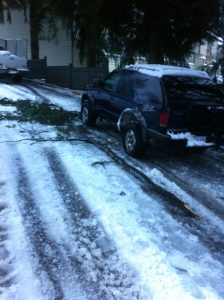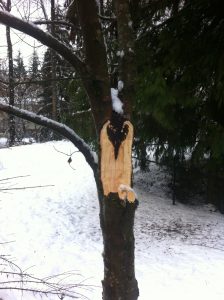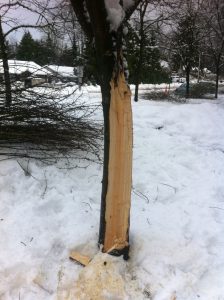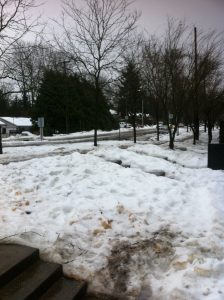It was yet another snow day. Just before Christmas. En route to a snow clearing session, we got a call to check out a damaged tree. So we turned around. Only the one damaged tree turned out to be eighteen. Mostly maples (Acer). It was shocking to see the trees fall apart after snowfall, overnight freezing and morning rain. The damage was recent and branches were snapping as we spoke to the garden liaison. She was clearly distressed and eager to speak to an arborist. I didn’t have good news for her.
Let’s examine the Acers on site. They clearly had lots of co-dominant stems with included bark. Why is that so bad?
- C0-dominant stems are not proper branches. Proper branches have several layers of overlapping wood a their junction points. Some of this wood is produced by the trunk and some of it by the branch. This means that the point of attachment is very strong!
- Included bark is a problem. Imagine two stems growing as if they were the leaders. They grow by producing bark, cambium, phloem and xylem. As the two stems grow bigger, some of their bark gets buried inside the junction. This only weakens the junction point and increases the chance of failure.
- Normal branches have bark protection zones. These are areas inside the wood, near the branch-trunk junction. They are rich in protective chemicals that help to prevent pathogens from reaching inside the trunk. So, when kids snap a branch on the way from school, the protection zone does its job of sealing the trunk from pathogens. Co-dominant stems lack these protection areas so diseases can travel down to the trunk. This also makes it difficult to remove one stem because the wound won’t get help with keeping disease out. Normally it would be good if you could prune one of the co-dominant stems right out.
- Trees with damaged co-dominant stems often die. The wounds are horrific and because they lack bark protection zones, pathogens, fungi and pests get in.
It turns out, maples are known for co-dominant stems. The site we were on looks very different after the costly removal of eighteen trees. What can you do? Port Moody hasn’t seen this much snow in a long time.
Day of failure pictures

Always consider safety! This Douglas fir (Pseudotsuga menziesii) branch came down five minutes after we arrived.
Post-removal picture







